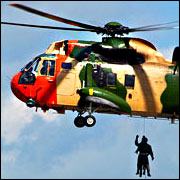
In the midst of an emergency while on a Grand Canyon rafting and rock-climbing trip last fall, Kevin Camp discovered first-hand the life-saving capabilities of satellite communicators.
When a member of his party fell off a rock and sustained serious injuries, Camp used a DeLorme inReach to contact rescue personnel, coordinate a helicopter landing, and keep family and friends updated about the situation.
“The inReach proved its superior emergency capabilities exquisitely,” Camp told TechNewsWorld.
DeLorme’s inReach, launched in 2011, is a two-way satellite communicator that uses the Iridium satellite network to allow users to track their journeys, initiate SOS messages, post updates to social media, and send and receive texts. It can be used as a stand-alone unit to send predetermined texts or paired with a smartphone or tablet to send unique texts.
That unique texting ability proved key, in fact, to coordinating the rescue effort in the Grand Canyon.
“With the inReach, I was able to text and continue doing other things, and when it had the split second to send a message, it did,” Camp explained. “I found my place with a decent signal on the hillside during the evacuation, and beyond that point in the trip I could be floating down the river, and the inReach would send my message when it had reception.”
Connecting Explorers to Civilization
Satellite communicators have revolutionized the way that people travel and explore. They’ve given adventurers an affordable option to satellite phones, and since help is only a push of a button away, they offer a sense of security when people are in the backcountry and off the grid.
In addition to inReach, there are a variety of other satellite communicators, including Globalstar’s SPOT Satellite GPS Messenger and BriarTek’s Cerberus, each with its own particular capabilities and distinctive combination of features. All of these devices are marketed to a range of explorers, adventurers, travelers, and even aid workers in remote locations around the world.
“These devices are game changers, because you’re using stuff you’re already comfortable with,” Joe Landa, owner ofBriarTek told TechNewsWorld. “The closer we can get to making it seamless, the more people can do it. I want people carrying and using these devices. We’re a safety company. We make stuff to bring people home who want to get found.”

The ability of these devices to track journeys and send updates to friends and family has fundamentally changed the way people travel and communicate about their travels.
“It give people peace of mind, knowing that they can check in with friends and family,” Greg Wilkinson, a distribution manager withGlobalstar said of the SPOT. “I hear from hikers, horseback riders, and skiers that it’s a great way of checking in with people at home, letting them know they’re OK without having to phone. It allows them to share the adventure. When they get to an interesting spot they can hit the OK button. Friends and family can see they’re on a great beach in the Caribbean, or on a mountain in the Rockies.”
If something does go wrong, they can summon help by sending messages to emergency contacts or, in the case of inReach or SPOT, by pressing the SOS button to alert the GEOS search and rescue network. The GPS-enabled devices can then lead rescuers directly to the person in need.
“It gives people the peace of mind to go into the great outdoors, knowing that if something does happen, they can summon help,” Wilkinson told TechNewsWorld.
No Substitute for Planning

No matter how many bells and whistles they have, however, these devices can’t replace good planning and intelligent actions when in potentially dangerous situations. The wilderness, after all, isn’t any less wild because of the presence of satellite communicators.
“I do the same things I was doing before I had the inReach in my life,” said Camp. “I do not feel any safer in the back country with the device, as it is not a substitute for coherent sound decision-making, observation, experience, and risk assessment.”
When used wisely, though, they can provide peace of mind and a safety net for those who like to venture beyond the limits of civilization — not to mention cell phone coverage.
“I use the inReach in all my adventures and expeditions,” explorerEric Larsen told TechNewsWorld.
“For me, it is a multifaceted tool that allows me to interact with others while being responsible about safety,” he explained. “I’ve used the inReach on climbing trips, day hikes, canoe trips, foreign travel and recently a first-ever bicycle expedition in Antarctica. I have it on so many trips because it is useful in most situations.”





















































